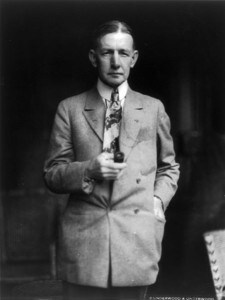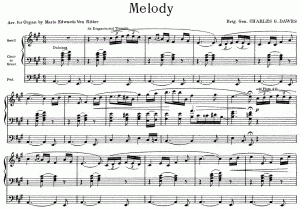The U.S. Vice President Who Wrote a Pop Music Hit
Barry Manilow, Van Morrison, the Four Tops, Cass Elliot, Isaac Hayes, Bing Crosby and Nat “King” Cole all owe a lot to a now obscure United States vice president and Nobel Peace Prize winner named Charles Dawes. Those musical artists, as well as dozens of others, recorded a song that the American statesman dashed off in a single sitting decades earlier. Dawes, who had a background in banking and law with no formal music training, never suspected that his tune would someday reach the very top of the pop charts in the U.S. and U.K.

The tale of that hit song, “It’s All in the Game,” begins in Marietta, Ohio, where Dawes was born in 1865. Long interested in music but discouraged by his parents from pursuing it as a profession, he taught himself passable skills in playing the piano and flute. He passionately attended concerts of visiting artists in Marietta and kept a diary of his impressions of their performances. Dawes eventually established himself as a banker in Illinois, but he never lost his love of music, helped form the Chicago Grand Opera company, and frequently sat at the keyboard to pass his idle minutes.
During one of those interludes at the piano in 1911, Dawes sketched out a tune that he liked very much. He soon returned to the piece and gave it a solo part for violin. His friend, the violinist and fellow Mariettan Francis MacMillan, heard the melody and fell in love. “It’s just a tune that I got in my head, so I set it down,” Dawes explained to MacMillan. “I never gave the thing a name. If you want it you can have it. It has served its purpose as a diversion for me.”
MacMillan made the most of that invitation. He sold it to a publisher, and before long Dawes’ piece, now titled Melody in A Major, was a light-classical hit. “I was walking down State Street and came to a music shop,” Dawes wrote of his discovery of the fame of his creation. “I saw a poster size picture of myself, my name plastered all over the window in large letters and the window space entirely filled with the sheet music.” Phonograph recordings by such artists as the violinist Fritz Kreisler sold by the tens of thousand.

In the years that followed, as Dawes became the first director of the U.S. Bureau of the Budget, formulated a plan for Germany’s payment of reparations to the Allies, was elected vice president on the Republican ticket with Calvin Coolidge in 1924, and shared a Nobel Peace Prize in 1925 for his work enabling Germany to handle its weighty war reparations, the Melody in A tailed its creator in performances by marching bands, string quartets, and a variety of often ill-fitting musical ensembles. Dawes grew weary of it. “If it had not been fairly good music I should have been subjected to unlimited ridicule,” he lamented.
The cacophony had quieted by the time Dawes died in 1951. Later that year, however, Melody in A began a new life as a hit pop song. Songwriter Carl Sigman — who would later write lyrics for “What Now My Love,” “A Day in the Life of a Fool,” and “Ebb Tide,” — got the tune stuck in his head and adapted it for “It’s All in the Game,” a song about the vicissitudes of love. When crooner Tommy Edwards recorded it first, the song climbed to eighteen on the pop charts. Edwards covered the song again in 1958, and this doo-wop version hit number one and became one of the defining songs of the 1950s. Recordings by a slew of pop, soul, jazz, R & B, and easy-listening artists followed and have continued unabated.
Dawes is the only U.S. vice president and Nobel prize winner to earn a credit for a hit song. At the end of his life he had at last given up on music. “Not long ago I tried to play ‘Tea for Two,’ which I used to play a lot,” he wrote, “but I won’t try it again.” He could no longer hear the musical overtones.
Further reading:
Timmons, Bascom N. Portrait of an American: Charles G. Dawes. Henry Holt and Company, 1953.
Was, David. “Tracing the History of a Song: ‘It’s All in the Game.’” Day to Day program transcript, April 5, 2006.
References (51)
References allow you to track sources for this article, as well as articles that were written in response to this article.
- Response: instagram giftsby Dorothy Hopskin at instagram online on November 15, 2018
- Response: Judi Pokerat Poker Online on November 16, 2018Jack El-Hai | Writer and speaker – Jack El Hai’s Blog – The U.S. Vice President Who Wrote a Pop Music
- Response: Click Hereby Admin at Makar Sankranti Guide on November 16, 2018
- Response: qq Onlineat Situs Poker Online on November 18, 2018Jack El-Hai | Writer and speaker – Jack El Hai’s Blog – The U.S. Vice President Who Wrote a Pop Music
- Response: Elongattorat Elongattor on November 18, 2018Jack El-Hai | Writer and speaker – Jack El Hai’s Blog – The U.S. Vice President Who Wrote a Pop Music
- Response: 2018 Black Fridayat 2018 Black Friday on November 19, 2018Jack El-Hai | Writer and speaker – Jack El Hai’s Blog – The U.S. Vice President Who Wrote a Pop Music
- Response: 2018 Black Fridayat 2018 Black Friday on November 19, 2018Jack El-Hai | Writer and speaker – Jack El Hai’s Blog – The U.S. Vice President Who Wrote a Pop Music
- Response: p34739at P34739 on November 19, 2018Jack El-Hai | Writer and speaker – Jack El Hai’s Blog – The U.S. Vice President Who Wrote a Pop Music
- Response: gamingat Gaming on November 19, 2018Jack El-Hai | Writer and speaker – Jack El Hai’s Blog – The U.S. Vice President Who Wrote a Pop Music
- Response: tipobetat Tipobet on November 20, 2018Jack El-Hai | Writer and speaker – Jack El Hai’s Blog – The U.S. Vice President Who Wrote a Pop Music
- Response: bandar super10 terpercayaat agen domino terbaik on November 22, 2018Jack El-Hai | Writer and speaker – Jack El Hai’s Blog – The U.S. Vice President Who Wrote a Pop Music
- Response: Poker Onlineat Situs Poker Online Terpercaya on November 23, 2018Jack El-Hai | Writer and speaker – Jack El Hai’s Blog – The U.S. Vice President Who Wrote a Pop Music
- Response: Situs Judi Pokerat QQ Poker on November 24, 2018Jack El-Hai | Writer and speaker – Jack El Hai’s Blog – The U.S. Vice President Who Wrote a Pop Music
- Response: Happy New Year Wallpapers HDby admin at new year on November 26, 2018
- Response: rubber stamp online makerat rubber stamp online maker on November 27, 2018Jack El-Hai | Writer and speaker – Jack El Hai’s Blog – The U.S. Vice President Who Wrote a Pop Music
- Response: Ip addressat 196.190.28.50 on November 28, 2018Jack El-Hai | Writer and speaker – Jack El Hai’s Blog – The U.S. Vice President Who Wrote a Pop Music
- Response: disco duro no arrancaat Consejos Sobre Recuperación De Datos on November 28, 2018Jack El-Hai | Writer and speaker – Jack El Hai’s Blog – The U.S. Vice President Who Wrote a Pop Music
- Response: Taehyunat Taehyun on November 29, 2018Jack El-Hai | Writer and speaker – Jack El Hai’s Blog – The U.S. Vice President Who Wrote a Pop Music
- Response: Outdoor Bluetooth Wireless Speakersby kwinson at Best Party Speakers on November 30, 2018
- Response: Merry Christmas Images Downloadby Admin at Christmas on November 30, 2018
- Response: microblading trainingat 3D Brows training on December 3, 2018Jack El-Hai | Writer and speaker – Jack El Hai’s Blog – The U.S. Vice President Who Wrote a Pop Music
- Response: Suggested Online siteat ladybug rocker on December 3, 2018Jack El-Hai | Writer and speaker – Jack El Hai’s Blog – The U.S. Vice President Who Wrote a Pop Music
- Response: click through the following pageat Poker on December 7, 2018Jack El-Hai | Writer and speaker – Jack El Hai’s Blog – The U.S. Vice President Who Wrote a Pop Music
- Response: Get free wsop chipsby admin at game play on December 10, 2018
- Response: Haunt The House Unblockedby admin at game play on December 10, 2018
- Response: Get Kissanime Apk Hereby admin at game play on December 10, 2018
- Response: Best Wsop Promo Codesby admin at game play on December 10, 2018
- Response: baby hazelby zahid at mousebreaker on January 4, 2019
- Response: Check Happy Valentines Day Imagesby Admin at valentine on January 16, 2019
- Response: Happy Valentines Day 2019 Celebrationby Admin at valentine on January 16, 2019
- Response: http://emojiart.info/by emo ji art at emojiart.info on January 17, 2019
- Response: 1 people like itby Moondric at SEO Terbaik on January 17, 2019
- Response: Download Valentines Day Wallpaper Nowby Admin at valentine on January 22, 2019
- Response: Collection Of Happy Valentines Day Cardsby Admin at valentine on January 22, 2019
- Response: happy 4th of july images Free Downloadby Admin at Usa Independence on February 1, 2019
- Response: Wireless Speakersby Kwinson at Best Budget Bluetooth Speaker on February 6, 2019
- Response: valentines day images Downloadby Admin at valentine on February 6, 2019
- Response: International Women’s Day Celebrationby International at international on February 6, 2019
- Response: medical evisa for indiaby e visa at e visa india on February 25, 2019
- Response: DABBL Brand Shower Doors, Enclosure, Cubicleby Roger at DABBL Brand on February 27, 2019
- Response: Audio Installation Servicesby Aaron at Hant It Up TVs on March 7, 2019
- Response: https://imothersdaymessages.com/by admin at Mothers Day on April 21, 2019
- Response: Download ICC Cricket World Cup 2019 PDFby admin at cricket on April 23, 2019
- Response: Click Here to get Toss Prediction Todayby admin at cricket on April 24, 2019
- Response: New Zealand Vs Sri Lanka ODI Match 3 Cwc 19by admin at cricket on April 25, 2019
- Response: daftar poker qq online terpercayaby lucito at higoshi on April 27, 2019
- Response: Toss Prediction Today Match Who Will Winby admin at cricket on May 6, 2019
- Response: indian tourist visaby onlinevisa at onlinevisa on May 27, 2019
- Response: best outdoor refrigeratorby shambhu at flashforward.io on July 3, 2019Great Information, it has lot for stuff which is informative.I will share the post with my friends.
- Response: calgary dj eventsby yycdjservices at yyc dj services on July 31, 2019
- Response: SEO Company Indiaby ezrankings.org at SEO Company India on August 1, 2019